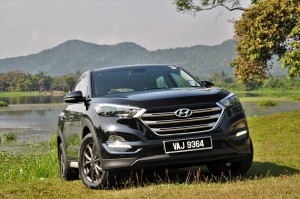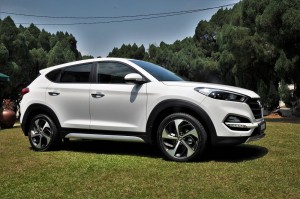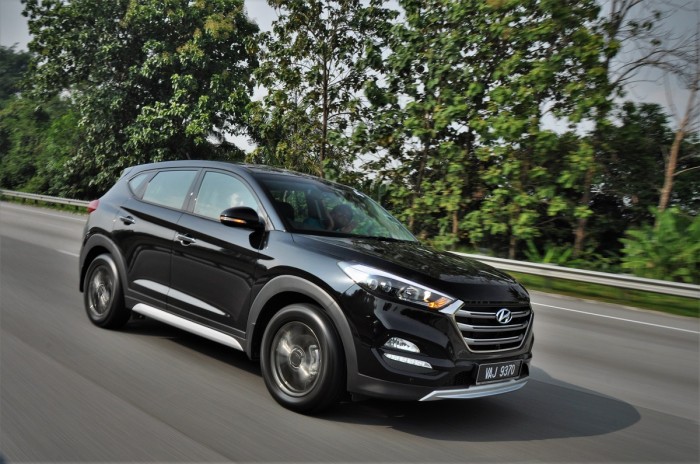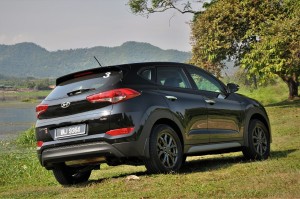Test Drive Review : Hyundai Tucson 1.6L T-GDI & 2.0L CRDi
What’s This?
Like the understated style of its Fludic 2.0 design language, Hyundai-Sime Darby Motors had earlier this year gave a couple of new turbocharged engines, an understated introduction into its line-up of the 3rd generation Tucson SUV, which we had reviewed previously, so we will be focusing mainly on the engines (the 1.6L GDI turbo petrol and 2.0L CRDi turbo diesel) and the driving in this review.
What About It?
Scuplted under the watch of Hyundai-Kia’s Chief Design Officer, Peter Schreyer, the Hyundai Tucson is a iF Design Award, and GOOD DESIGN Award, winner. It is also the only vehicle in the small SUV category to receive “Good” ratings for both driver and passenger in the Insurance Institute for Highway Safety (IIHS) small overlap crash test.
The exterior differentiating factors to the non-turbo variants are the use of projector LED headlamps, instead of the halogen projector version, and static bending lights, as well as the ‘Turbo’ or ‘CRDi’ badges on the vehicle. The Tucson comes with 17″ wheels but you can opt for the larger 19″ set that fills up the wheel arches quite nicely. Sizing up would naturally impact ride and handling as well as fuel economy so that’s a matter of personal preference.
What’s Inside?
New in the turbocharged Tucson variants are a front parking camera, a smart powered tailgate with hands-free operation, and a new front-facing digital video recorder replacing the Lukas unit found in the non-turbo variant. The reverse camera view is via a built-in display in the rear view mirror; the front parking camera view is displayed in the 8″ touchscreen display.
What’s Underneath?
 Starting off with the 1.6L turbocharged petrol engine (T-GDI) which is the cheaper of the 2 turbocharged variants… this is a single scroll turbo (unlike the twin scroll in the Elantra Sport 1.6L), and as such is less beastly at 175 hp at 5,500rpm (vs 201 hp) but torque is remains the same i.e. 265 Nm between 1,500 – 4,500 rpm.
Starting off with the 1.6L turbocharged petrol engine (T-GDI) which is the cheaper of the 2 turbocharged variants… this is a single scroll turbo (unlike the twin scroll in the Elantra Sport 1.6L), and as such is less beastly at 175 hp at 5,500rpm (vs 201 hp) but torque is remains the same i.e. 265 Nm between 1,500 – 4,500 rpm.
 The 2.0L CRDi R-series turbocharged diesel produces peak power of 176 hp at a lower 4,000 rpm and gets 51% more torque i.e. 400 Nm between 1,750 – 2,750 rpm. Both engines claim to bring the Tucson up to a top speed of 201 km/h, while 0 – 100 km/h acceleration times are 9.1 seconds (turbo petrol) and 9.3 seconds (turbo diesel) respectively.
The 2.0L CRDi R-series turbocharged diesel produces peak power of 176 hp at a lower 4,000 rpm and gets 51% more torque i.e. 400 Nm between 1,750 – 2,750 rpm. Both engines claim to bring the Tucson up to a top speed of 201 km/h, while 0 – 100 km/h acceleration times are 9.1 seconds (turbo petrol) and 9.3 seconds (turbo diesel) respectively.
Both the turbo variants are front-wheel drive, with power applied via a 7-speed double clutch transmission for the 1.6L petrol and 6-speed torque converter automatic for the 2.0L diesel.
In comparison, the 2.0L naturally aspirated (non-turbo) petrol engine (which sits in the base spec Tucson Elegance as well as range-topping Tucson Premium 4WD) has 153 hp and 192 Nm, a top speed of 181 km/h and a 0 – 100 km/h time of 11.1 seconds (timed in the front-wheel-drive Elegance).
What’s It Like?
 Hyundai claims the Tucson has sedan-like ride comfort, with the use of front McPherson struts and rear multi-links, and that’s not a far-fetched claim although one can argue that modern SUVs have improved so much that this is an expected characteristic. Nonetheless, passenger derrieres are comfortably cushioned and the ride is seldom fussy save for the extremely poorly tarred roads.
Hyundai claims the Tucson has sedan-like ride comfort, with the use of front McPherson struts and rear multi-links, and that’s not a far-fetched claim although one can argue that modern SUVs have improved so much that this is an expected characteristic. Nonetheless, passenger derrieres are comfortably cushioned and the ride is seldom fussy save for the extremely poorly tarred roads.
Body roll is largely contained as long as you drive this as an SUV and not a low-slung 2-door sports coupe. The acceleration from both types of turbo engines were a lot more enthusiastic than the non-turbo variant, and propelled the Tucson up to the highway speed limit in a jiffy. From then on, it was just a matter of maintaining the momentum for a fuel-sipping cruise.
 On a well-behaved stint, the 1.6L turbo petrol could cover about 13 km on a liter of fuel. After some spirited driving, the average was reduced to 10.3 km per liter, which is quite good considering we didn’t set out on the trip to be frugal.
On a well-behaved stint, the 1.6L turbo petrol could cover about 13 km on a liter of fuel. After some spirited driving, the average was reduced to 10.3 km per liter, which is quite good considering we didn’t set out on the trip to be frugal.
With the 2.0L turbo diesel, it was 14.5 km per liter on a highway run that spent roughly half the time at the speed limit. Between the 2 turbo engines, the better low-end grunt of the diesel makes short work of taking the Tucson up to a comfortable cruising speed and you will likely see fuel cost savings if you frequently do long distance drives. Meanwhile, the petrol version with its effective dual clutch gearbox, is more easily excitable at high speeds and in theory, will probably fare better in terms of fuel savings than the diesel in urban traffic.
Who Is It For?
 With fuel prices on a consistent uptrend lately, small capacity turbo engines seems the way to go if you want to skimp on the fuel bill, and these 2 candidates from Hyundai fit the bill if you’re looking for a solidly built mid-sized vehicle for the family. Both are similarly equipped with the necessary creature comforts and toys so it’s a matter of your driving requirements and preference of fuel type.
With fuel prices on a consistent uptrend lately, small capacity turbo engines seems the way to go if you want to skimp on the fuel bill, and these 2 candidates from Hyundai fit the bill if you’re looking for a solidly built mid-sized vehicle for the family. Both are similarly equipped with the necessary creature comforts and toys so it’s a matter of your driving requirements and preference of fuel type.
How Much?
The Hyundai Tucson 1.6L T-GDI is priced at RM 145,688 while the 2.0L CRDi is RM 155,788 (on the road without insurance).
All Tucson variants are covered by a 5-year or 300,000 km (whichever comes first) warranty and are entitled to 50,000 km free service within the first 3 years. There is also a 24-hour road assist service available for new and existing Hyundai vehicles.
Gallery:























































